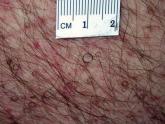Article

What Is Your Diagnosis? Pemphigoid Gestationis (Herpes Gestationis)
- Author:
- Erwin E. Argueta, MD
- Jaime A. Tschen, MD
A 37-year-old pregnant woman at 25 weeks’ gestation presented with a generalized pruritic rash of 3 weeks’ duration. The rash had initiated around...
Quiz

Hairs With an Irregular Shape
- Author:
- Erwin E. Argueta, MD
- Jaime A. Tschen, MD
A 74-year-old man was evaluated for numerous peculiar hairs on the back that had been present for several years. He reported no other dermatologic...
